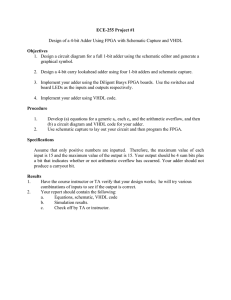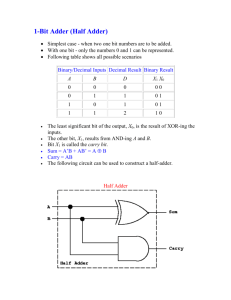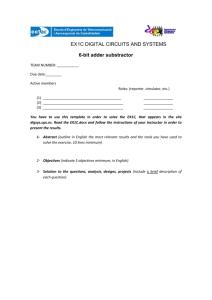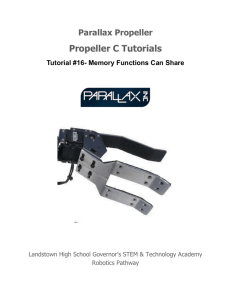Lecture 33
advertisement
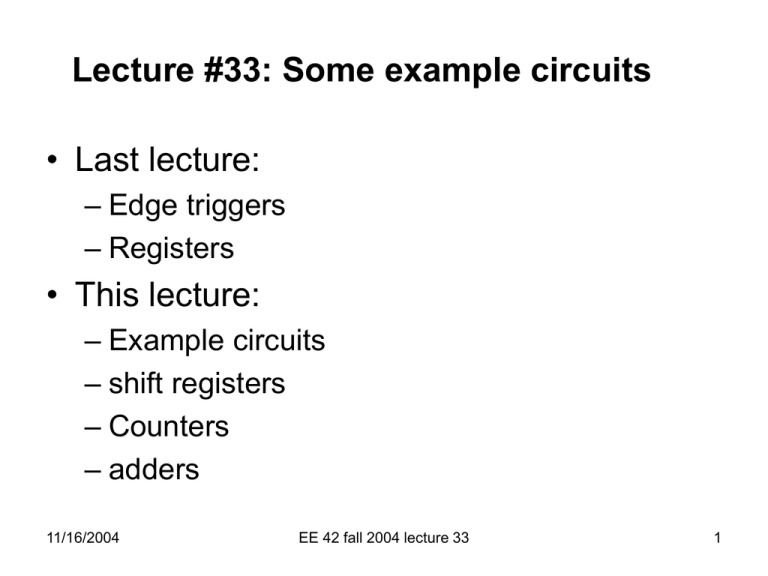
Lecture #33: Some example circuits • Last lecture: – Edge triggers – Registers • This lecture: – Example circuits – shift registers – Counters – adders 11/16/2004 EE 42 fall 2004 lecture 33 1 Examples of useful combinatorial circuits • There are several patterns of combinatorial logic which appear fairly often, here are several examples • The examples will be given in terms of gates as well as logic equations, but not in a minimal representation, but just a clear example • In most cases, a computer program such as Verilog would be responsible for producing optimal implementations anyway. 11/16/2004 EE 42 fall 2004 lecture 33 2 Pattern recognizer The output of this pattern recognition circuit is 1 only if the input is 10110, and otherwise zero A B C D E Q Q ( A B C D E) 11/16/2004 EE 42 fall 2004 lecture 33 3 Decoder •n inputs, 2n outputs – one output is 1 for each possible input pattern, all other outputs are 0 11/16/2004 A B O1 O2 O3 O4 0 0 1 1 0 1 0 1 1 0 0 0 0 1 0 0 0 0 1 0 0 0 0 1 EE 42 fall 2004 lecture 33 4 Decoder •n inputs, 2n outputs – one output is 1 for each possible input pattern, all other outputs are 0 1 A B 2 3 4 11/16/2004 EE 42 fall 2004 lecture 33 5 CMOS switch • A CMOS switch will allow a logic level to pass if activated, does not allow current through the gate if not activated 11/16/2004 EE 42 fall 2004 lecture 33 6 Multiplexer (MUX) •n-bit selector and 2n inputs, one output – output equals one of the inputs, depending on selector I1 I2 I3 I4 A B 11/16/2004 O 2 input decoder EE 42 fall 2004 lecture 33 7 Buffer • A buffer passes a logic level while increasing its drive capability • A design like the previous slide would likely be implemented with a buffer at its output Often, wider transistors in the second stage 11/16/2004 EE 42 fall 2004 lecture 33 8 Half Adder • A half adder takes two bits and produces their sum, with a carry • It is called a half adder because it does not have a carry input A B Sum Output Carry out 11/16/2004 EE 42 fall 2004 lecture 33 9 Half adder 11/16/2004 A B O C 0 0 0 0 0 1 1 0 1 0 1 0 1 1 0 1 EE 42 fall 2004 lecture 33 10 Full Adder •Add two bits and carry-in, produce one-bit sum and carry-out. 11/16/2004 A B Cin S Cout 0 0 0 0 0 0 0 1 1 0 1 0 1 0 1 1 0 0 0 1 1 0 0 1 1 0 1 0 1 1 0 0 0 1 1 1 1 1 1 1 EE 42 fall 2004 lecture 33 11 One bit Full adder • A single bit full adder can be made from two half adders and an or gate A B O Half adder C Sum out Carry in Half adder C Carry out 11/16/2004 EE 42 fall 2004 lecture 33 12 Full adder as a logic block • We can use our full adder as a logic block to make a multi-bit adder by cascading the carry line Sum Cin Full adder Cout (one bit) A 11/16/2004 B EE 42 fall 2004 lecture 33 13 Three-bit Adder Sum0 half adder Sum1 Carry Full adder Sum2 Carry Full adder (one bit) (one bit) (one bit) A0 B0 A1 B1 A2 B2 11/16/2004 EE 42 fall 2004 lecture 33 Carry 14 Adders • It is interesting to note that in hardware, it is typical to dedicate an adder for one particular use, as contrasted with software on a CPU, where numbers are moved around to be added by a central adder. • This is because the additional selectors and wires to move around numbers takes more area than just putting in separate adders for each purpose. 11/16/2004 EE 42 fall 2004 lecture 33 15 Some register based digital blocks • There are also several common digital blocks which are based around flip-flop registers, such as multi-bit data registers, shift registers, and counters 11/16/2004 EE 42 fall 2004 lecture 33 16 Definition:Register •A register is a collection of flip-flops with similar controls and logic •A register stores a multi-bit value. – Stored values somehow related (e.g., form binary value) – Share clock, reset, and set lines – Similar logic at each stage 11/16/2004 EE 42 fall 2004 lecture 33 17 Registers • Example: a collection of D-flip-flops, all controlled by a common write enable (WE). – When WE transitions from 1 to zero (falling edge), a n-bit value D is written to register. OUT1 Reset “0” OUT2 R S D Q OUT3 R S D Q R S D Q OUT4 R S D Q Write enable IN1 11/16/2004 IN2 IN3 EE 42 fall 2004 lecture 33 IN4 18 Shift Register • Holds samples of past input values and shifts them in sequence into a string of flipflops IN D Q D Q D Q D Q OUT shift 11/16/2004 EE 42 fall 2004 lecture 33 19 Shift Register • Holds samples of input – Store input values in sequence – 4-bit shift register used as a serial to parallel converter: OUT1 OUT2 OUT3 OUT4 IN D Q D Q D Q D Q CLK 11/16/2004 EE 42 fall 2004 lecture 33 20 Parallel to serial converter Reset “0” R S D Q R S D Q R S D Q R S D Q Output Shift “0” literal IN1 MUX IN2 MUX IN3 MUX IN4 MUX Load/Shift 11/16/2004 EE 42 fall 2004 lecture 33 21 Shift Register Application • Parallel-to-serial conversion for serial transmission parallel outputs parallel inputs serial transmission 11/16/2004 EE 42 fall 2004 lecture 33 22 Pattern Recognizer • Combinational function of input samples – In this case, recognizing the pattern 1001 on the single input signal OUT OUT1 IN D Q OUT2 D Q OUT3 D Q OUT4 D Q CLK 11/16/2004 EE 42 fall 2004 lecture 33 23 Use of counters • Counters are often used when something needs to happen a certain number of times. • Counters can be designed to be preset to particular values, to count up or down, and/or to trigger some action at a particular count by the use of a pattern recognizer. 11/16/2004 EE 42 fall 2004 lecture 33 24 Binary Counter • Logic between registers (not just multiplexer) – XOR decides when bit should be toggled – Always for low-order bit, only when first bit is true for second bit, and so on OUT1 D Q OUT2 D Q OUT3 D Q OUT4 D Q CLK "1" 11/16/2004 EE 42 fall 2004 lecture 33 25 Sequential Logic Summary • Fundamental building block of circuits with state – R-S latch, R-S master/slave, D master/slave, edge-triggered D FF – Latch and flip-flop • Timing methodologies – Use of clocks – Cascaded FFs work because prop delays exceed hold times – Beware of clock skew • Asynchronous inputs and their dangers – Synchronizer failure: what it is and how to minimize its impact • Basic registers – Shift registers – Pattern detectors – Counters 11/16/2004 EE 42 fall 2004 lecture 33 26


